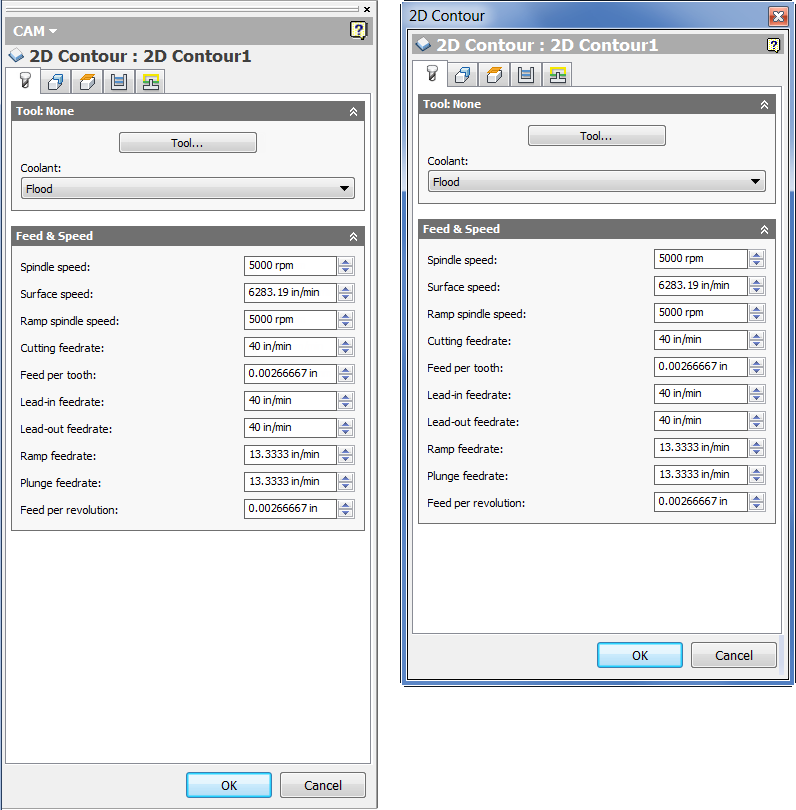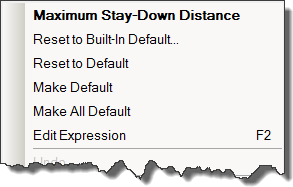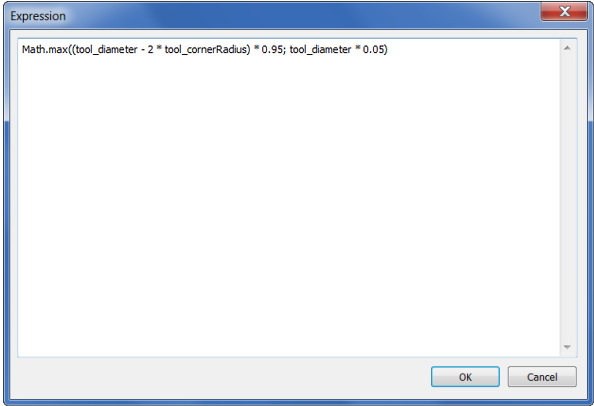The tabs on the Operation dialog box share a similar layout for all milling operations. The machining settings are grouped into five tabs that provide a quick way to navigate between the settings and greatly reduces the amount of scrolling required.

The active Geometry tab in the Operation dialog for a 2D Adaptive operation.
 Tool tab
Tool tab
This tab lets you select a tool for the operation. You can also edit the tool in the Tool Library and set the feeds and speeds for the operation.
 Geometry tab
Geometry tab
This tab contains all of the primary geometry selections and defines what to machine and where. Depending on the type of operation, and the Inventor HSM version, the following groups are available here: Geometry, Machining Boundary, Slope, Rest Machining, Tool orientation, Model, and Avoid/Touch Surfaces.
 Heights tab
Heights tab
This tab controls the heights at which the operation functions. In general, it controls the primary Z-levels of the machining and, depending on the operation, lets you select the following levels: Clearance Height, Retract Height, Feed Height, Top Height, and Bottom Height.
 Passes tab
Passes tab
This tab controls how the actual cutting toolpaths should be generated. The parameters on this tab include: Tolerance, Stepover, Stepdown, Stock to Leave, Fillets, and Smoothing.
 Linking tab
Linking tab
This tab controls how all of the non-cutting toolpaths should be generated. The parameters on this tab include: Retraction policy, Safe distance, Lead-in and Lead-out, Ramping, Transitions, and Entry position(s).
Operation Dialog Position Options
Normally, the Operation dialog box shares the same space as the CAM Browser. You can separate the Operation dialog from the CAM Browser so that it can float freely or be docked to a more convenient location by doing the following:
- On the ribbon, click
Ribbon:
CAM tab
 Manage panel
Manage panel
 Options
Options
 . The CAM Options dialog box is displayed.
. The CAM Options dialog box is displayed. - Click the User Interface tab.
- Deactivate the Combine Operation dialog with CAM Browser check box.
- Click OK to exit the CAM Options dialog box.
The next time a machining strategy is selected, the Operation dialog box will display independent of the CAM Browser.

At the left, the Operation dialog box shares the same space as the CAM Browser. At the right, it is shown separated from the CAM Browser in a floating state.
Making and Resetting Parameter Defaults
As far as possible, Inventor HSM provides working default values for each of the strategy parameters found in the Operation dialog box. You can control the default values of each parameter by right-clicking over the parameter name to display the pop-up context menu shown below.

The current parameter name (in bold) is displayed at the top of the pop-up context menu. The remaining menu items offer the following options:
- Reset to Built-in Default - Resets the current field's expression to the out-of-the-box (system) default. This option ignores any user-saved default.
- Reset to Default - Resets the current field's expression to the user-saved default for the parameter/strategy.
- Make Default - Sets the current field's expression as the default for the corresponding parameter/strategy combination.
- Make All Default - Sets all of the current object's expressions as the defaults for the corresponding strategy.
- Edit Expression - Most of the parameters in Inventor HSM have default values based on expressions involving other parameters, such as the tool diameter (referenced by tool diameter in an expression). You can enter a new expression directly in the parameter field or you can modify an existing expression using the Expression dialog box by selecting Edit Expression from the pop-up context menu or by pressing function key F2.

The Expression dialog box
The names for referencing other parameters can be determined by holding down the Shift key while hovering your mouse over a parameter field.

Parameter names are shown in the tooltip when holding Shift